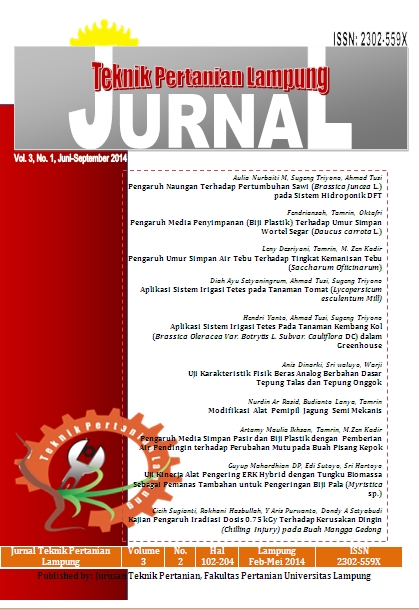PHYSICAL CHARACTERISTICS TEST OF FAKE RICE COMPOSTING WITH TARO AND ONGGOK FLOURS
Abstract
Analog rice is made of non paddy flour. The utilization of taro flour as material for analog rice needs to be developed. The purpose of this study was to measure the characteristics of analog rice made from taro flour and onggok flour such as uniformity of grain, bulk density, moisture content, water absorption, and extention ability. Granulation of the analog rice was done using a granulator with 6 different compositions of taro flour-coarse cassava flour, and taro flour − fine cassava flour with ratio of 75:25 , 85:15 , 95:5, respectively. The results showed that the diameter of grain of analog rice affect uniformity, moisture content, water absorption, and extention ability. In mixture of taro flour and coarse cassava flour yielded diameter of 2-4.70 mm, bulk density of 0.77-0.84 g/cm3, the water content of 11.84-12.85 %, 62.15-94.25 % water absorption, 9.30-13.46 % extention ability, whereas the mixture of cassava flour and taro flour produced diameter > 4.70, bulk density 0.74-0.83 g/cm3, the water content of 10.76-13.31 %, 57.03-76.94 % water absorption, 11.33-12:53 % extention ability. Starch content of material affect the water absorption and extention ability of the analog rice.Keywords : Taro, taro flour, onggok flour, rice, analog rice.
Downloads
Published
2014-09-30
Issue
Section
Articles
License
- Authors who publish with this journal agree to the following terms:
- Authors retain copyright and grant the journal right of first publication with the work simultaneously licensed under a Creative Commons Attribution-ShareAlike 4.0 International Lice that allows others to share the work with an acknowledgement of the work's authorship and initial publication in this journal.
- Authors are able to enter into separate, additional contractual arrangements for the non-exclusive distribution of the journal's published version of the work (e.g., post it to an institutional repository or publish it in a book), with an acknowledgement of its initial publication in this journal.
- Authors are permitted and encouraged to post their work online (e.g., in institutional repositories or on their website) prior to and during the submission process, as it can lead to productive exchanges, as well as earlier and greater citation of published work (See The Effect of Open Access).
Jurnal Teknik Pertanian Lampung

JTEPL is licensed under a Creative Commons Attribution-ShareAlike 4.0 International License.

